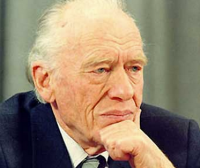










Gleb Lozino-Lozinskiy was a Vital Core in the development of Buran(Space shuttle), the Soviet equivalent of the US Space Shuttle.
Early Life and his Research Career
Lozino-Lozinskiy was born on December 25, 1909, in Kiev, presently Ukraine. He graduated from the Khrakov Mechanical and Machine-building Institute in 1930 and worked in the aviation industry starting in 1932.
In 1941, Lozino-Lozinskiy joined a design bureau led by Artem Mikoyan, the developer of the Soviet fighter jets known around the world as MIGs. One of the early projects led by Lozinskiy was work on the first Soviet jet engine with an adjustable nozzle. Lozino-Lozinskiy was also responsible for the production of several generations of MIG fighter jets.
Starting in1965, while still working for Mikoyan, Lozino-Lozinskiy led a super-secret project named Spiral which was an early Soviet attempt to develop a small manned space plane.
This mini-shuttle would have been launched on the back of a hypersonic aircraft, itself capable of reaching Mach 6 (or six times of the speed of sound). After separation from the carrier aircraft, the Spiral would have been boosted into orbit by a detachable rocket stage.
Although several prototypes of the Spiral space plane were built and tested in atmospheric flights, the program was terminated in favor of a much more ambitious Soviet effort, aimed at responding to the development of the Space Shuttle in the United States. In 1976, Lozino-Lozinskiy was put in charge of NPO Molniya, a newly created design center on the outskirts of Moscow. The organization had the unprecedented task of developing a 100-ton reusable orbiter with capabilities similar to or exceeding those of the US Space Shuttle. Unlike the US Shuttle, the Soviet winged orbiter would ride into orbit on a super-heavy booster developed separately at NPO Energia.
Known as Buran, the Soviet shuttle made a single unmanned orbital flight and completed the world’s first automated landing in 1988. However, with the collapse of the Soviet Union in 1991, the Buran program was cancelled due to lack of funds.
After the demise of the Buran, Lozino-Lozinskiy led NPO Molniya in the search for a new mission. Along with the development of lightweight airplanes, the center proposed a number of unconventional aerospace systems, aimed at reducing the cost of launching commercial payloads into space.
A small reusable space plane, developed under Lozino-Lozinskiy’s leadership during the 1990s, was designed for launch on top of the giant Antonov-225/Mriya aircraft. Known as MAKS, or Multi-purpose Reusable Aerospace System, the spacecraft has never left the drawing board due to lack of viable investors.
Death
Lozino-Lozinskiy died on November 28, 2001 at the age of 91.